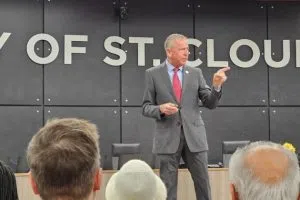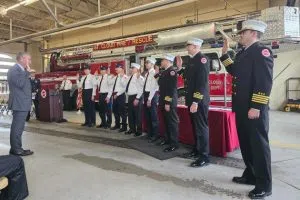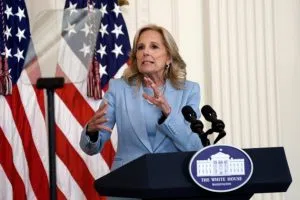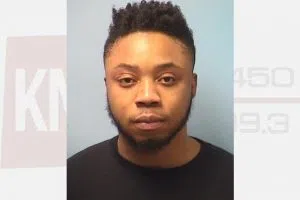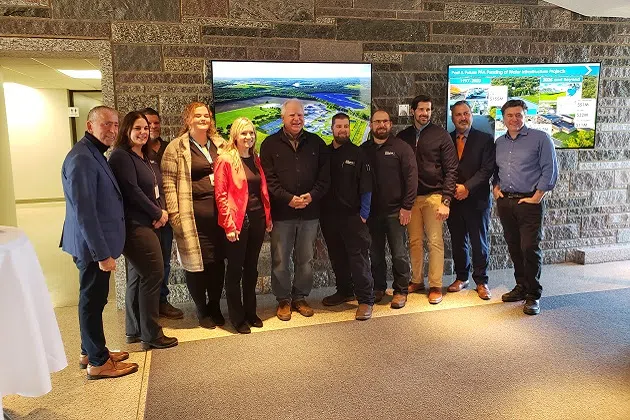(KNSI) – Governor Tim Walz toured the world-class St. Cloud Wastewater Treatment Facility Tuesday, which could be used as a model in other parts of the state.
It is cutting edge, generating more than enough power through operations and an on-site solar farm to run on its own, and can even sell power back to the electrical grid. St. Cloud Public Services Director Tracy Hodel says everything that comes into the facility, either through a sewer or waste from area businesses.
“We’ve totally embraced the paradigm shift of going from a sewage plant to a wastewater treatment plant, and now we’re called the nutrient energy and water recovery facility because that’s truly what we’re doing. We’re recovering the energy, we’re recovering the nutrients from it, and then we’re also recovering the water and discharging clean water into the Mississippi River.”
Governor Walz is barnstorming across Minnesota, stressing infrastructure and says regional assets like what is available in St. Cloud are the types of projects that will get consideration in next year’s bonding bill.
The facility creates energy by using bacteria to break down sewage and high-sugar concentrated waste from breweries, farms, and restaurants. It also can make fertilizer from water with elevated levels of phosphorous and ammonia. St. Cloud representative Dan Wolgamott says it proves that one person’s waste is another’s treasure.
“This place really embodies that. Especially the fact that they can take waste and turn it into revenue-producing materials that are in high demand just shows the innovation that the mayor and his team have put forward. And it shows what we can do when we make investments with state dollars, where we can leverage that in federal dollars.”
Six communities now use the plant to treat their wastewater. Senator Aric Putnam was also part of the tour, and he stressed the collaboration here in central Minnesota as a model for the rest of the state.
“It’s that we’re doing great stuff together. When I talk to my colleagues in the legislature, and I say, ‘Oh yeah, you know the United Way is working with this other organization, which is working with these other organizations…’ they’ll get incredibly jealous because no one else collaborates the way we do. And we wouldn’t have these great things that we have to celebrate and show off if we didn’t actually get along pretty well.”
—————-
HEAPER, PFA AND HOW THE SAUSAGE IS MADE
A combination of loans and principal forgiveness from the Minnesota Public Facilities Authority is pumping over $25 million into the treatment plant and regional water system next year. Walz told those in attendance Tuesday that this is the perfect example of where it makes sense to leverage state and federal dollars together to complete a project. Hodel explains what improvements are scheduled.
“We have two existing force mains right now that run from 33rd Street South all the way to this treatment facility, which is about three miles of pipe. They’re from the early 1970s, the installation and they’re out of its useful life. We’ve had some emergency repairs, because it’s aging and deteriorating.”
Several communities have proposals for the next cycle. Statewide, the total requested is up to about $5 billion, according to representative Dan Wolgamott. Renovations for a medical school at CentraCare Plaza on the border of St. Cloud and Sartell also received praise from legislators at the event. Wolgamott who echoed the focus on infrastructure, including for schools like St. Cloud State University.
“Now HEAPRE stands for Higher Education Asset Preservation. And that’s at the colleges and universities across our state. You know, everybody likes to get excited about the big brand new facility and the big ribbon cutting, but it’s really important that we take care of what we have.”
Wolgamott toured the Herb Brooks National Hockey Center and the education building on campus with the Minnesota Management and Budget commissioner last week.
Walz said his office will wait for the February budget surplus projection before finalizing its proposal. The house and senate will bring forward their own versions and negotiations will begin in March in the run up to the end of the legislative session in late May. Putnam talks about how a compromise is hashed out.
“There’s a genuine effort to balance bonding resources between rural, urban, suburban communities and between Republican and Democratic legislators. It’s not always perfect. But there’s definitely that effort to make sure that balance happens, but that means no one gets everything they want. So, that’s how the process kind of works out.”
Putnam says the sense of balance was seen last year as area legislators from both chambers and both sides of the aisle came together to get $7 million for the Great River Childrens Museum.
___
Copyright 2023 Leighton Enterprises, Inc. All rights reserved. This material may not be broadcast, published, redistributed, or rewritten, in any way without consent.
